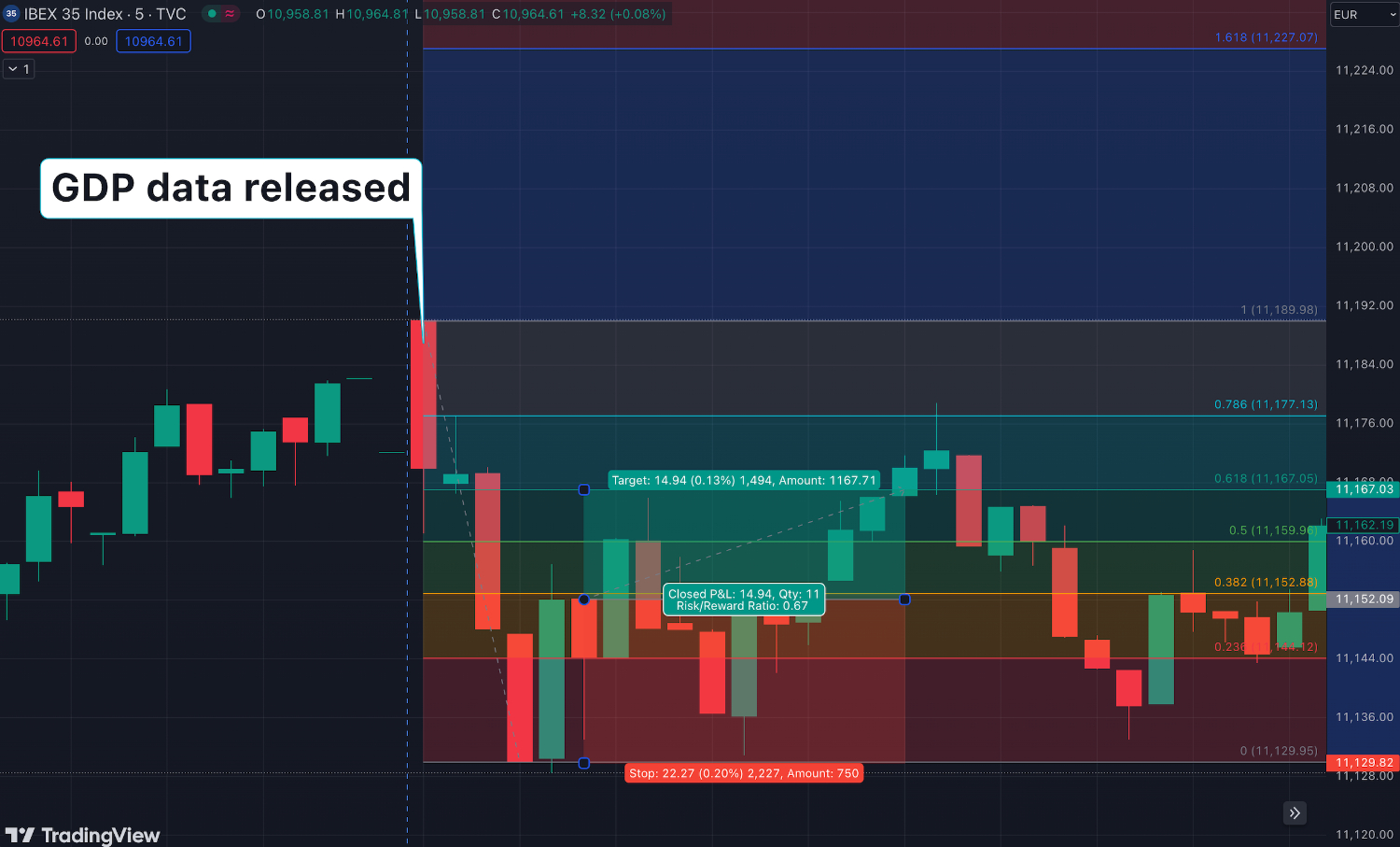Day Trading in Spain



Whether you’re drawn by quick profits on IBEX 35 stocks or split-second decisions on EUR/USD, day trading in Spain offers a unique avenue for financial growth.
Spain’s dynamic economy, with strong banking, energy, telecoms, and tourism industries and well-regulated markets, overseen by the National Securities Market Commission (CNMV), provides a solid foundation for trading.
This guide will walk you through the essentials of day trading in Spain, from understanding the regulatory and tax landscape to helping you take your first steps.
Quick Introduction
- Day trading is regulated by the National Securities Market Commission (CNMV), a ‘green-tier’ financial body, that provides strong safeguards for Spanish investors.
- Spain’s primary stock exchange, the Madrid Stock Exchange, operates from 09:00 to 17:30 CET and in 2023, its average daily trading volume was approximately €2.5 billion, reflecting the vibrant activity in the Spanish markets.
- Short-term traders should report earnings to the Spanish Tax Agency and may need to pay capital gains taxes, which typically range from 19% to 26%, depending on your returns.
Top 4 Brokers in Spain
Following our latest tests, these 4 brokers emerged as the best for active traders in Spain:
See More Day Trading Platforms in Spain
What Is Day Trading In Spain?
Day trading in Spain involves buying and selling financial instruments, such as stocks (e.g. Banco Santander) and commodities (e.g. Wheat as Spain is one of Europe’s biggest grain importers), within the same trading day to capitalize on short-term market movements.
Spanish CFDs brokers also provide derivatives suitable for fast-paced trading strategies, while forex trading in Spain is huge, offering access to leading currency pairs in Europe and worldwide (e.g. EUR/USD).
The IBEX 35 also includes significant companies like Santander, Telefónica, and Repsol, offering numerous opportunities for day traders.
Is Day Trading Legal In Spain?
Day trading is legal in Spain and regulated by the CNMV to ensure market integrity, transparency, and trader protection.
Registering with an authorized broker that complies with CNMV regulations provides the necessary platforms and tools for day trading within Spain’s legal framework.
Regulations also aim to protect you from excessive risks associated with day trading. For instance, Spanish brokers must provide educational resources and warnings to ensure you know the potential financial risks involved.
To ensure you’re working with a legitimate broker, I recommend utilizing the CNMV’s ‘Companies Search‘ function to verify their regulatory status.
Additionally, the CNMV maintains a ‘Search Engine for Warned Companies‘ suspected of operating without proper authorization. You can make an informed decision about your broker by checking both resources.
How To Start Day Trading In Spain
Day trading in Spain involves several essential steps to ensure a smooth and successful trading experience. Here’s how to get started:
- Selecting the right broker in Spain for your needs is crucial for day trading. Ensure the CNMV regulates the broker or that it has permission to accept Spanish traders as part of the EU’s ‘passporting’ initiative, to guarantee compliance with Spanish financial laws.
- Once you’ve chosen a top day trading broker in Spain, you must open an account. This typically involves providing identification documents such as Documento Nacional de Identidad (DNI), proof of address, and financial information. After your account is approved, deposit funds using wire transfer, credit card, or other accepted methods, with PayPal leading as the most popular digital wallet in Spain.
- Decide which assets you want to actively trade. Common choices include Spanish companies listed on the Madrid Stock Exchange (such as Banco Sabadell, Grifols, and Endesa) and currencies containing the Euro (such as EUR/USD and EUR/GBP). CFD trading in Spain lets you speculate on upward/downward price movements across a wide variety of markets.
Trade in Action
To help you understand how day trading in Spain works in practice, here is a first-hand scenario demonstrating a short-term trading strategy for the IBEX 35.
Event Background
A highly anticipated economic event was scheduled: the release of Spain’s quarterly GDP growth figures. This event had the potential to cause significant volatility in the IBEX 35.
Data Analysis
Positive Spanish GDP figures would generally be bullish for the IBEX 35. Higher-than-expected GDP growth indicates a strengthening economy, which can lead to increased investor confidence and higher demand for stocks. This, in turn, can drive up the prices of the stocks included in the IBEX 35, leading to an overall rise in the index.
The data release showed Spain’s economy experienced slightly more robust growth than anticipated in the first quarter of 2024, achieving a 0.8% increase from 0.7% in the previous quarter. This marked the highest growth rate since the second quarter of 2022.
According to the National Statistics Institute, the rise was mainly due to increased household spending, which grew at 0.4%.

Trade Entry
The data release showed solid growth figures, and I anticipated a positive market reaction as the numbers exceeded expectations. However, I observed bearish price action on the IBEX 35.
Uncertain of my analysis, I waited for a few 5-minute candles to close to see if there was an opportunity to trade a reversal.
Twenty minutes later, after noticing a bullish reversal candle, I recognized an opportunity and initiated a long position based on a 0.618 Fibonacci retracement, as I expected strong upward momentum in response to the positive economic news.
However, as price action looked indecisive, I set a tight stop-loss to minimize risk, aiming to capture a short-term gain based on intraday price action.
Trade Exit
The initial positive sentiment from the GDP figures created a drop in the IBEX 35. Still, I remained confident in my reversal trade. Less than an hour later, the market had gained a little ground and reached my take-profit of around 14 pips.
If I was wrong, my trade would have hit my stop-loss of around 22 pips. This was a negative risk-reward ratio trade because the reward was less than the potential risk.
How Is Day Trading Taxed In Spain?
Day traders in Spain are required to report their earnings to the Spanish Tax Agency (Agencia Estatal de Administración Tributaria) and pay capital gains taxes, which range from 19% to 26%, depending on the profit.
Accurate record-keeping and timely tax filings are essential to comply with Spanish tax laws. Additionally, the CNMV enforces rules to prevent market manipulation and insider trading, ensuring that your activities do not violate these regulations.
Bottom Line
Day trading in Spain is an exciting and potentially profitable endeavor supported by a well-regulated and dynamic market environment.
With a solid understanding of market regulations, sector-specific trends, and effective use of the best day trading platforms in Spain, you can navigate the Spanish markets and capitalize on short-term price movements to achieve your financial goals.
Recommended Reading
Article Sources
- National Securities Market Commission (CNMV)
- Madrid Stock Exchange
- Companies Search - CNMV
- Search Engine for Warned Companies - CNMV
- Spanish Tax Agency (Agencia Estatal de Administración Tributaria)
- Quarterly National Spanish Accounts - National Statistics Institute
- Most Popular Payment Methods in Spain
The writing and editorial team at DayTrading.com use credible sources to support their work. These include government agencies, white papers, research institutes, and engagement with industry professionals. Content is written free from bias and is fact-checked where appropriate. Learn more about why you can trust DayTrading.com



